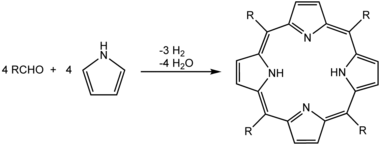Precipitation (chemistry)
This article has multiple issues. Please help improve it or discuss these issues on the talk page. (Learn how and when to remove these template messages)
|

In an aqueous solution, precipitation is the process of transforming a dissolved substance into an insoluble solid from a supersaturated solution.[1][2] The solid formed is called the precipitate.[3] In case of an inorganic chemical reaction leading to precipitation, the chemical reagent causing the solid to form is called the precipitant.[4]
The clear liquid remaining above the precipitated or the centrifuged solid phase is also called the supernate or supernatant.
The notion of precipitation can also be extended to other domains of chemistry (organic chemistry and biochemistry) and even be applied to the solid phases (e.g. metallurgy and alloys) when solid impurities segregate from a solid phase.
Supersaturation
The precipitation of a compound may occur when its concentration exceeds its solubility. This can be due to temperature changes, solvent evaporation, or by mixing solvents. Precipitation occurs more rapidly from a strongly supersaturated solution.
The formation of a precipitate can be caused by a chemical reaction. When a barium chloride solution reacts with sulphuric acid, a white precipitate of barium sulfate is formed. When a potassium iodide solution reacts with a lead(II) nitrate solution, a yellow precipitate of lead(II) iodide is formed.
Inorganic chemistry
Precipitate formation is useful in the detection of the type of
A common example of precipitation from aqueous solution is that of silver chloride. When silver nitrate (AgNO3) is added to a solution of potassium chloride (KCl) the precipitation of a white solid (AgCl) is observed.[5][6]
The
Reductive precipitation

The
The Walden reductor made of tiny
Colloidal suspensions
Without sufficient attraction forces (e.g.,
Digestion and precipitates ageing
Digestion, or precipitate ageing, happens when a freshly formed precipitate is left, usually at a higher temperature, in the solution from which it precipitates. It results in purer and larger recrystallized particles. The physico-chemical process underlying digestion is called Ostwald ripening.[7][8]
Organic chemistry

While precipitation reactions can be used for making
Precipitation may also occur when an antisolvent (a solvent in which the product is insoluble) is added, drastically reducing the solubility of the desired product. Thereafter, the precipitate may be easily separated by
Biochemistry
Proteins purification and separation can be performed by precipitation in changing the nature of the solvent or the value of its relative permittivity (e.g., by replacing water by ethanol), or by increasing the ionic strength of the solution. As proteins have complex tertiary and quaternary structures due to their specific folding and various weak intermolecular interactions (e.g., hydrogen bridges), these superstructures can be modified and proteins denaturated and precipitated. Another important application of an antisolvent is in ethanol precipitation of DNA.
Metallurgy and alloys
In solid phases, precipitation occurs if the concentration of one solid is above the solubility limit in the host solid, due to e.g. rapid quenching or
In
Precipitation of
Industrial processes
Hydroxide precipitation is probably the most widely used industrial precipitation process in which metal hydroxides are formed by adding calcium hydroxide (slaked lime) or sodium hydroxide (caustic soda) as precipitant.
History
Powders derived from different precipitation processes have also historically been known as 'flowers'.
See also
- Coprecipitation
- Effervescence, the "up-arrow"
- Precipitate-free zone
- Salting in
- Salting out
References
- ^ "Precipitation (Chemical) - an overview". ScienceDirect. Retrieved 2020-11-28.
- Encyclopedia Britannica. Retrieved 2020-11-28.
- ^ "precipitate". Merriam-Webster.com Dictionary. Retrieved 2020-11-28.
- ^ "precipitant". Merriam-Webster.com Dictionary. Retrieved 2020-11-28.
- ISBN 978-1-133-71013-4.
- ISBN 978-1-337-67132-3.
- ISSN 0001-6160.
- S2CID 14865117.
- .
- .
- ^ Dupont, J., Consorti, C., Suarez, P., de Souza, R. (2004). "Preparation of 1-Butyl-3-methyl imidazolium-based room temperature ionic liquids". Organic Syntheses
{{cite journal}}: CS1 maint: multiple names: authors list (link); Collected Volumes, vol. 10, p. 184. - S2CID 98639891.
Further reading
- Zumdahl, Steven S. (2005). Chemical Principles (5th ed.). New York: Houghton Mifflin. ISBN 0-618-37206-7.




